I don’t often write about boats and perhaps this is strange considering that I live in a port. So, let’s go for a wander down Slip St.
This is the street in Fremantle where ships were built many years ago and then launched down the slipway at the west end of the street into the sea.
As you can see, there is still some wooden boat buidling going on. My brother, Sam, studied wooden boat building in a workshop on Slip St. a few years ago. He helped to build a ten metre long whaling boat, exactly the same design of boat that was used in the second half of the nineteenth century to take pilots (people who would help guide ships into strange harbours) out to jump onboard incoming ships off Rottnest (the island off the coast of WA). Here it is…

The design is called a clinker, because of the overlapping planks that make up its hull. Five men would sit in it and pull on these oars. In making this vessel my brother made of himself a point of connection with hundreds of years of human history.
This is a piece of technology whose use emits zero CO2 pollution into the atmosphere.
It is also lovely to look at. Not to mention made with an impressive amount of skill, care and attention.
As the process of producing a bit of steel uses ten times as much energy as the equivalent wooden plank, wooden boats such as this one also have it over vessels with metal hulls when it comes to discussions of in-built energy (assuming you harvest your wood in a sustainable manner of course).
In Perth, a sunny city on a coast, there are tens of thousands of boats used for cruising around and having fun in, and most of them are propelled by many hundreds of litres of petrol. No leisure activity should necessitate the burning of fossil fuels. Unless you can change formula one racing to electric vehicles, then get rid of it. This is where boats like the one above come in.
I’d happily row around the Swan river on a summer evening in this thing with four or five of my friends and a few cold beverages stowed within reach. If I wanted to go further afield then one could contemplate another zany and avant-garde form of zero-emissions technology: a sailing boat.
Imagine this: It is 1865 and you are standing on the wooden deck of a seventy metre long tea clipper, surging west over the Indian Ocean. Four masts tower above your head, each with six massives sheets of white canvas billowing outwards, not to mention topgallants and other smaller sails full of the salty wind. The hold is full of wool from Australia, or maybe tea from China. Ships from earlier centuries, like the Duyfken, were happy to steam along at six knots with the wind behind them. As you stand there on the deck know that beneath your feet nearly one thousand tons of wooden clipper is moving at twenty knots.
As I imagine this moment I realise that this is a point in which I can see a sophisticated technology, the culmination of hundreds of years of human ingenuity and maritime history, shine forth proudly. And then, at the same time, I realise that I’m looking backwards in time at our past.
In 2006 the world’s fastest sailing vessels are now slick and shiny catamarans made out of carbon fibres, but after well over a hundred years of tecnological development and many millions of dollars invested, they can only add about another ten knots to the speed of these nineteenth century clippers. To this day ships like the Cutty Sark and the Flying Could were the fastest ever commercial sail vessels.
Oil is currently seventy two dollars a barrel, and big sailing ships take many hands on deck to operate, each sailor needing to be paid. Sailing ships are not economical to transport goods for trade at present only because full environmental costs are not built into the cost of a barrel of oil. When it is the China Clippers of the 1860s and 1870s may start to look like not only the beautiful, silent and swift paragons of human civilization that they truly were, but also blueprints for a saner future.


